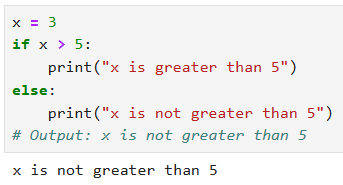Conditional statements in Python allow you to execute code based on certain conditions. They are fundamental for controlling the flow of a program. Here's a comprehensive overview of how to use conditional statements in Python:
1. if Statement
The if statement is used to test a condition. If the condition evaluates to True, the code block under the if statement is executed.
2. if-else Statement
The else statement follows an if statement and runs when the if condition is False.
3. if-elif-else Statement
The elif (short for "else if") statement checks another condition if the previous if condition was False
4. Nested if Statements
You can nest if statements within other if statements to create complex conditions.
5. Logical Operators
You can use logical operators (and, or, not) to combine multiple conditions.
Using and:
not:6. Conditional Expressions (Ternary Operator)
Python supports conditional expressions (also known as ternary operators) for short conditional assignments.
Summary
ifstatement: Executes a block of code if the condition is true.elsestatement: Executes a block of code if theifcondition is false.elifstatement: Checks multiple conditions.- Logical operators:
and,or,notto combine conditions. - Nested
ifstatements: Create complex conditions. - Ternary operator: Short conditional assignments.
By mastering conditional statements, you'll be able to control the flow of your programs effectively and handle various logical scenarios.








Comments
Post a Comment